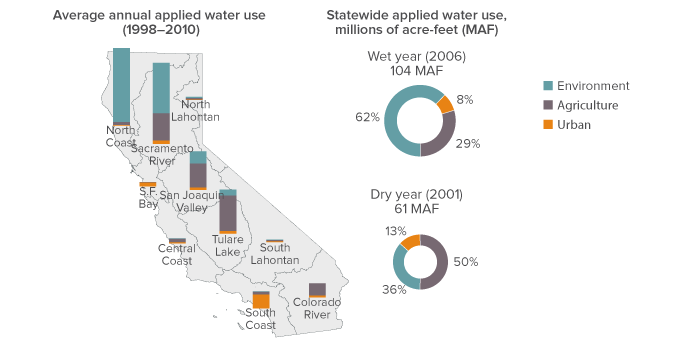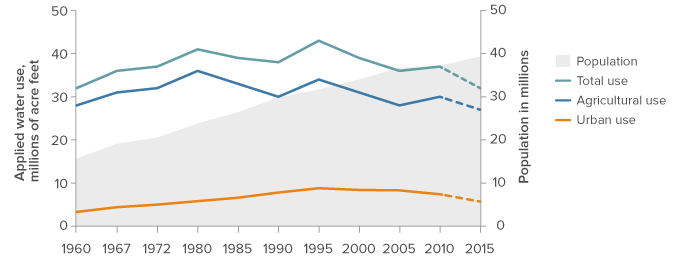Originally posted at the Public Policy Institute of CA.
By Jeffrey Mount and Ellen Hanak.
- Water in California is shared across three main sectors.
Statewide, average water use is roughly 50% environmental, 40% agricultural, and 10% urban, although the percentage of water use by sector varies dramatically across regions and between wet and dry years. Some of the water used by each of these sectors returns to rivers and groundwater basins and can be used again. (These official estimates were last updated in 2010, so they do not reflect recent drought-related changes in water use.) - Environmental water provides multiple benefits.
Environmental water use falls into four categories: water in rivers protected as “wild and scenic” under federal and state laws, water required for maintaining habitat within streams, water that supports wetlands within wildlife preserves, and water needed to maintain water quality for agricultural and urban use. More than half of California’s environmental water use occurs in rivers along the state’s north coast. These waters are largely isolated from major agricultural and urban areas and their wild and scenic status protects them from significant future development. In dry years, the share of water that goes to the environment decreases dramatically as flows diminish in rivers and streams. During this latest drought, the state also reduced water for the environment to reserve some supplies for farms and cities.
Water use varies dramatically across regions and between wet and dry years

SOURCE: Department of Water Resources (2013). California Water Plan Update (Bulletin 160-13).
NOTE: The figure shows applied water use. The statewide average for 1998-2010 was 79.8 MAF. Environment (40.5 MAF average) includes water for “wild and scenic” rivers, required Delta outflow, instream flows, and managed wetlands. Urban (8.3 MAF) includes residential, commercial, and industrial uses, and large landscapes. Agriculture (31 MAF) includes water for crop production. Net water use—i.e., the volume consumed by people or plants, embodied in manufactured goods, evaporated, or discharged to saline waters—is lower. The figure excludes water used to actively recharge groundwater basins (3% for urban and 1% for agriculture on average), conveyance losses (2% for urban and 7% for agriculture), and water used for energy production (less than 2% of urban use).
- Agricultural water use is falling, while the economic value of farm production is growing.
Approximately nine million acres of farmland in California are irrigated, representing roughly 80% of all water used for businesses and homes. Higher revenue perennial crops—nuts, grapes, and other fruit—have increased as a share of irrigated crop acreage (from 27% in 1998 to 32% in 2010 statewide, and from 33% to 40% in the southern Central Valley). This shift, plus rising crop yields, has increased the value of agricultural water used. Farm production generated 60% more gross state product in 2014 than in 1980, even though farm water use was about 15% lower. But even as the agricultural economy is growing, the rest of the economy is growing faster. Today, farm production and food processing generate about 2% of California’s gross state product, down from about 5% in the early 1960s. - Despite population growth, total urban water use has also fallen.
The San Francisco Bay and South Coast regions account for most urban water use in California. Both rely heavily on water imported from other parts of the state. Total urban water use has been falling even as the population grows. Even before the latest drought, per capita water use had declined significantly—from 232 gallons per day in 1990 to 178 gallons per day in 2010—reflecting substantial efforts to reduce water use through pricing incentives and mandatory installation of water-saving technologies like low-flow toilets and shower heads. In 2015, per capita use fell to 130 gallons per day in response to drought-related conservation requirements. Much of the recent savings focused on reducing landscape watering, which makes up roughly half of all urban water use. It is too early to know how much of these savings will persist beyond the drought.
Both agricultural and urban water use have fallen during the latest drought

SOURCES: Water use in 1960–2010: California Water Plan Updates (Department of Water Resources, various years). Water use in 2015: author estimates using urban water conservation reports from the State Water Resources Control Board and agricultural water use estimates from UC Davis, as reported in E. Hanak et al., What If California’s Drought Continues?, Table A5 (PPIC 2015). Population: Department of Finance.
NOTE: The figure shows applied water uses as described above. Except for 2015 (a severe drought year), the figure reports estimates for normal rainfall years. Pre-2000 estimates are adjusted to levels that would have been used in a year of normal rainfall. Estimates are for water years (October to September), except for urban use in 2015, which is for the calendar year.
- The current drought exposes major water use challenges.
Agriculture relies heavily on groundwater during droughts—particularly in the Central Valley—but more sustainable groundwater management will be needed to maintain this key drought reserve. The increase in perennial crops, which need to be watered every year, has made Central Valley farming even more vulnerable. In urban areas, the greatest potential for further water savings lies in long-term reductions in landscape irrigation—a shift requiring changes in plantings and watering habits. Finally, state and federal regulators must make tough decisions about how and when to allocate water to the environment during a drought. They are faced with balancing short-term economic impacts on urban and agricultural water users against long-term harm—even risk of extinction—to fish and wildlife.




